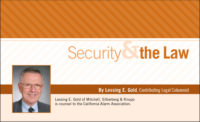A rather interesting case was filed in the United States District Court for the District of Oregon against the United States. The action was a claim for negligence against the defendant arising out of alleged injuries to her hearing as a result of an alarm on a United States Postal Service (USPS) vending machine.
The USPS office used a vending machine to dispense postal products to the public. The particular machine had a security alarm and strobe light security feature. Standard customer use would not trigger the security alarm. The alarm was designed to sound if the customer hit or moved the machine or otherwise manipulated it outside the normal course of selecting and paying for postal products. The machine was temperamental to the extent that the alarm would sound if the machine drawer was open and the person stocking it could not carefully key in the access code. The machine did not bear a warning telling customers that an alarm would sound if children played on the machine or if a customer jostled the machine. The purpose of the security alarm was to prevent theft and damage to the machine and to alert postal service employees to a potential security issue.
The USPS filed a motion for summary judgment to strike the plaintiff’s complaint.
In discussing the motion for summary judgment, the court indicated that the plaintiff sued the USPS office for negligence and that the USPS was liable for the “negligent or wrongful act or omission of any employee . . . acting within the scope of his office or employment, under circumstances where the USPS, with a private person, would be liable to the claimant in accordance with the law of the place where the act or omission occurred.” Therefore, the court determined that it must apply the law of the state of Oregon where the alleged tort occurred.
Citing Oregon law, the court pointed out that in common law negligence actions, the defendant’s liability for the plaintiff’s injury depended not on whether defendant owed a duty to the plaintiff, but on whether the defendant’s conduct “unreasonably created a foreseeable risk to a protected interest of the kind of harm that befell the plaintiff.” Therefore, the court determined that to prove a claim for negligence, the plaintiff must establish: (1) that defendant’s conduct caused a foreseeable risk of harm, (2) that the risk was to an interest of a kind that the law protects against negligent invasion, (3) that defendant’s conduct was unreasonable in light of the risk, (4) that the conduct was a cause of plaintiff’s harm, and (5) that plaintiff was within the class of persons and plaintiff’s injury was within the general type of potential incidents and injuries that made the defendant’s conduct negligent.
The court then determined that the existence and magnitude of the risk, bears on the foreseeability of harm. The foreseeability and cost of avoiding the risk bear on the reasonableness of defendant’s conduct. These clearly are empirical questions.
The USPS argued that its conduct did not cause a foreseeable risk of harm, because the level of noise emitted by the security alarm was within applicable safety standards and that the lack of complaints concerning hearing-related injuries caused by the alarm made such an injury unforeseeable. The plaintiff argued that an injury from the alarm was foreseeable because the postmaster was aware that the alarm was too loud and that the postmaster was not surprised that the plaintiff suffered a hearing-related injury from her exposure to the alarm. Further the plaintiff argued that the hyper-sensitive nature of the alarm and the possibility of hearing loss from exposure made it foreseeable that the defendant’s failure to warn customers of a loud alarm would result in a customer suffering a hearing-related injury when the alarm was improperly triggered.
The court pointed out that Oregon courts have consistently held that even where a statutory standard of care does not apply to a tort defendant, compliance with safety rules promulgated by state and federal authorities provides some indication of whether the defendant met the relevant standard of care. The court pointed out that although the parties disagreed about the level of noise to which the plaintiff was exposed, the plaintiff’s noise exposure estimate fell within the Occupational Health and Safety Administration’s maximum levels for industrial noise exposure, the National Fire Protection Association fire alarm and signaling code maximum total sound pressure and Uniform Federal Accessibility Standards for audible alarm signals maximum decibels.
The USPS cited cases referencing OSHA’s noise exposure regulations, but the court pointed out that it was not required to grant summary judgment on a negligent claim merely because the noise exposure fell below the maximum allowable levels authorized by OSHA.
The court pointed out that in this case the postmaster’s testimony indicated that he was aware that the alarm was too loud, but not that the alarm was harmful or injurious. The court also indicated that the postmaster had indicated that when the alarm was activated, he thought it was too loud and had seen customers hurriedly leave the lobby to get away from the machine or cover their ears when the alarm sounded. Thus, despite the lack of complaints of hearing-related injuries, the postmaster attempted to reduce the volume of the alarm. The court therefore found that these facts might permit a reasonable juror to find that the United States’ conduct in continuing to use the loud alarm created a foreseeable risk of hearing-related injury.
The court notwithstanding determined that overall the relevant factors compel a finding that there is no genuine issue of material fact as to whether the USPS conduct was unreasonable in light of the risk.
That the likelihood and magnitude of the risks of hearing-related injury were low and that the cost to prevent such a risk by eliminating the alarm was high, therefore, this case was one where the reasonableness of a defendant’s conduct need not be determined by a fact finder. As a matter of law, the USPS acted reasonably by employing the alarm. Therefore, the defendant’s motion for summary judgment was granted.
Readers Ask
Q: A short time ago, a non-customer of our company called during off hours and requested our service personnel to respond to a problem that they were having with their security system. The caller indicated that it was an emergency and it was necessary to repair the system immediately. We dispatched a repair person who identified the problem and made the minor repair to reinstate the system. The owner of the premise was onsite, our repair person indicated what the charge was for the repair and was paid at the site. I know it is after the fact, but does our company have any exposure as a result of the repair that was made?
A: You should never undertake any repair on anyone else’s system, whether it is a proprietary system, as apparently this was, or a monitored system, without obtaining a signed work order. If at some future time, if the alarm system does not work properly and the owner suffers some type of a loss, it is very possible that as you were the last person to touch the system an action may be brought against you for improperly repairing the system or for causing the system to malfunction, which created the loss.
If you are called upon to repair or do any maintenance for any system where you do not have a contract signed in advance, before you undertake any repair or modification of the system, you should have the owner of the premise, or a properly designated representative, sign a work order that includes the appropriate limitation of liability, liquidated damage or third-party indemnification provision. Once you undertake the responsibility of repairing or modifying the system, there may well be a duty imposed with a potential liability. The fact that the owner paid for the service on the spot does not justify the potential exposure in the event there is a loss.
To ask Les Gold a question, e-mail sdm@bnpmedia.com.






